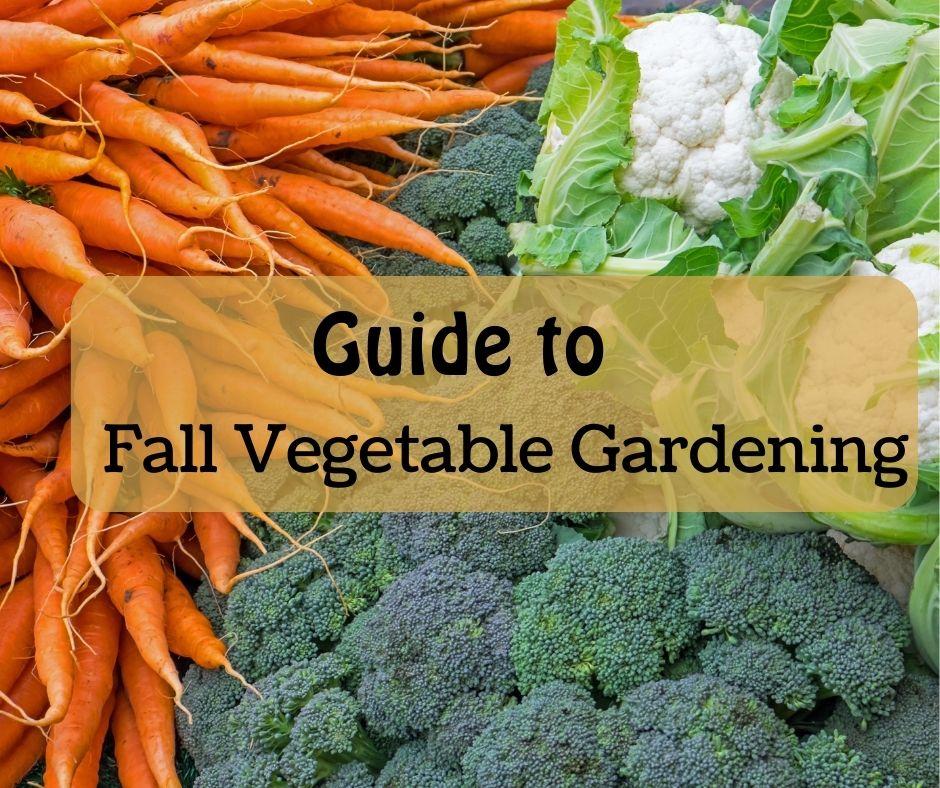The days are getting shorter and fall is on the way so it's time to think about planting cool season and short maturity vegetables for your fall garden. With the right plants and the right timing, fall can be one of the most successful and satisfying times of year to have a vegetable garden.

There are lots of great choices when it comes to vegetables that do well as the weather cools in fall.
Salad Greens: Crops such as lettuce, spinach, arugula, and mesclun are great for fall harvest because they mature quickly, grow well when the weather is cool, and are less likely to bolt or go to seed than spring planted crops. Both spinach and lettuce germinate poorly in warm soil (above 60 degrees) so if you are starting plants in late summer, cover beds with shade cloth after planting or start seeds indoors and transplant.
Hardy Greens: Fall is a great time to grow these nutritious crops. Kale, collards, Swiss chard, mustard greens, and bok choy all thrive in cooler weather. A few light frosts will even sweeten the taste of your kale. If you plan to harvest kale at full size, plant it about two months before your frost date, but if you are growing it as "baby" greens, you can sow seeds just a few weeks before frost.
Cole Crops: Like kale, Brussels sprouts taste best after sweetened by a light frost. But it takes a long time to mature, so be sure to get it on to your planting schedule in early to midsummer. Other cabbage family members that are suited to fall harvest include broccoli, cabbage, kohlrabi, and cauliflower.Root Crops: Beets, carrots, turnips, and radishes are all suitable for fall harvests. Root crops that mature in the cooler weather of fall will be sweet and mild. In the warmest areas, you can grow these crops right through the winter months.
Peas: These grow well in the cooler weather of fall, but can be damaged by frost, especially the developing pods. So try to time your fall pea sowing so plants mature a week or two before the fall frost date, and be prepared to cover plants if an early frost threatens. Keep the seed bed well watered to ensure good germination.
When to Plant for a Fall Garden
Planting times for fall crops will depend on where in the country you garden. Gardeners in southern areas will be able to plant later and have a wider variety of crops to choose from than those who garden where frost comes at the end of September or earlier.
To figure out the best fall planting times for your garden, start with the average date of your first hard fall frost (when temperatures dip to 28 degrees), since most cool-season crops can take a light frost without harm. Then take the days to maturity for the crop you plan to grow and count back this number of days from the frost date. (If the days to maturity listed is from transplant, not seeding, add another 4 weeks to this figure.) Because plants grow more slowly in the shorter, cooler days of fall, add a ″fall factor″ of another week or two to the maturity time. Then add in the length of the expected harvest period and you've arrived at your planting date.
As an example, the days to maturity for Black Seeded Simpson lettuce is 45 days. Add a 7 day ″fall factor″ and a 14 day harvest period for a total of 66 days. If your fall frost is around November 1, you'd need to plant your seeds by August 26. If you plan to offer your plants protection you can plant 2-3 weeks later and still expect to get a good harvest.
Use our very own Planting Calendar to give specific states for starting seeds as well as transplanting plants for best success.
Tips for Fall Vegetable Crops
-Plant in succession: Plant fast-maturing crops such as lettuce, arugula, mustard, mesclun, and mache in succession. Make a small planting every few weeks from midsummer on to enjoy a continued harvest through the fall.
-Gamble a little: Every season is different and you never know when the really cold weather will hold off, giving you a longer harvest. If you're willing to push the envelope and make your last plantings a little later than recommended, you may be rewarded with an extra long harvest season some years.
-Giving your plants some protection from the cold is another way to extend the gardening season. Cold frames, fabric row covers, cloches, and low tunnels can all offer varying degrees of protection and extend the harvest well beyond that of the open garden.
-Mulch root crops: You can extend your harvest of beets, carrots, turnips, and parsnips by mulching over them in the ground before the ground freezes hard. Place a foot deep layer of straw on top of the plants, extending out about 18 inches on either side of the row. Move the mulch aside to dig the roots as needed, then cover the plants back over. Even in northern areas, you can often continue your harvest up until early winter this way.

 Victory Seed Company has all the seeds you want for your best garden in 2024.
Victory Seed Company has all the seeds you want for your best garden in 2024.
For 25 years, the family-owned Victory Seed Company has provided the highest quality vegetable, herb and flower seeds to families across the country. We are passionate about providing you the best seeds available that give excellent germination, robust plants, and the harvest you want. With a catalog of over a thousand varieties, we have everything, and our prices are the kinds that we'd want to pay. We have hundreds of yesterday's heirloom vegetables, as well as today's award winning hybrid selections. Get to know us by visiting our website and browsing through our online vegetable seed catalog.